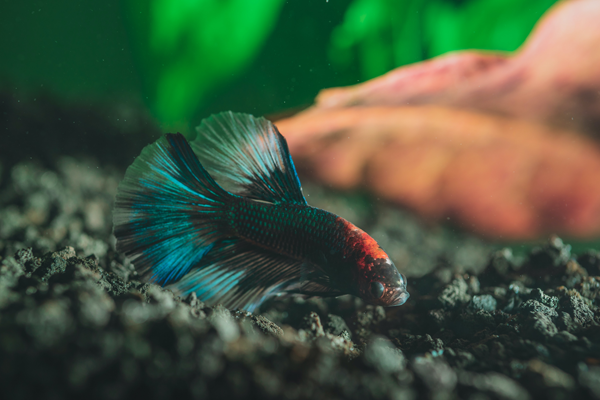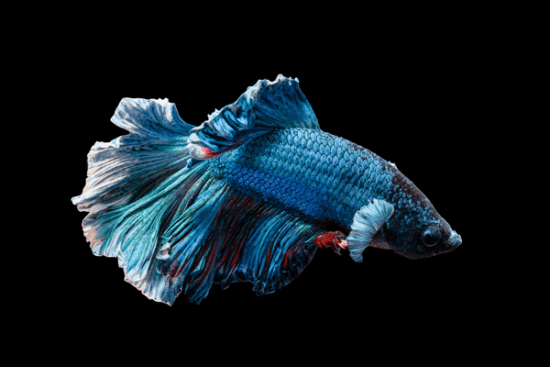Betta Fish Information
Betta fish, also known as the Siamese Fighting Fish, has been in the fish-keeping hobby for quite some time. They are colorful, beautiful, but highly territorial fish with outstanding personalities. They’re a great introductory fish for children and adults due to their ease of keeping. They do not require too much space, have gorgeous colors, and have wonderful personalities. They also have a nice long life of 3 – 5 years when living under healthy conditions. There are also so many more varieties of betta fish compared to 10-15 years ago. You can find betta fish for sale both online and in person. They are very common fish sold at pet stores.
Betta fish may seem dull at a pet store but are very charismatic fish! They will recognize their owner and often swim up to the glass to greet you. With practice, they can even learn tricks. They’re wonderful animals and we will continue this article by going over different requirements for keeping betta fish.
Aquarium Requirements
There are a few misconceptions about a betta fish aquarium. People think bettas do perfectly fine living in a cup of water. That is not the case. Although they are fairly easy to care for they should be kept in something larger than a cup! Our recommendation to keep a betta happy and healthy is to keep it in an aquarium or fish bowl of 5 gallons or more. This will provide enough swimming space. I always recommend more space if you can provide it. Betta fish accessories and decorations can be used to provide your betta fish with a refuge when stressed.
Betta fish do best with a filtration system in the fish tank. Usually, an aquarium with a hang on the back filter should suffice. If they are being kept in a round bowl, look into providing a sponge filter for their filtration. Check out 7 Best Hang On the Back Power Filters for Freshwater Aquariums to get an idea of great hang on the back filters for your betta.
This beautiful fish will thrive with a large range of water parameters:
- Temperature: 75° – 86° F
- KH: 0 – 25
- pH: 6.0 – 8.0
Bettas are very versatile fish that thrive in a nice range of water parameters. It is important to provide good filtration and a heater to try and keep parameters as stable as possible. Stability in water is very important to keep fish alive. Help keep nitrates and phosphates down by adding live plants! There are many great starter plants for new fish keepers such as Anubias, crypts, and java fern. Check out 3 Easy To Care for Aquatic Plants for more information.
Betta Food & Diet
Betta fish aren’t very picky with food. Most importantly, monitor how much you feed your fish to prevent overfeeding. Extra food that falls to the bottom of your aquarium will break down and may cause spikes in nitrates and phosphates. Betta fish will happily eat flake food, pellet food, and an occasional treat of bloodworms and/or brine shrimp. Watching a betta eat their food is always the best part of keeping them.
Tank Mates for a Betta Fish
Most people know this but still needs to be mentioned. There should only be one male betta in an aquarium. Males will most likely fight until one dies. From experience, it is not wise to keep male and female bettas in a small enclosure unless they are breeding. On the other hand, although female bettas are not as vibrant and colorful, they should be able to coexist with one another in the same fish tank.

Betta fish should be ok with other peaceful such as tetras, rasboras, and cory cats in aquariums that are 20 gallons or larger. The fish that are kept with bettas should not have flashy colorations. Besides showing aggression towards other bettas and fish that look similar to it. I would also avoid keeping bettas with fish that are known to be fin nippers.
Betta fish and snails should peacefully co-exist in an aquarium. Bettas may try to eat baby snails but larger ones should do well. They will spend their day cleaning algae off decorations, and glass, and munching on leftover food that may fall to the bottom of the aquarium. These invertebrates are perfect for aquariums with limited space.
Keeping Betta fish and shrimp is a little risky. Bettas should do fine with larger shrimp, such as the Amano Shrimp. However, small shrimp such as Neocaridina may become a meal for your betta. It all comes down to the temperament of your betta.
Betta Breeding
Breeding betta fish in a freshwater aquarium is very possible but will still require quite a bit of work. First, you must set up two aquariums that will house the male in one and the female in the other. Give your fish time to settle into their new home for a few months. Once preparations to breed begin, a breeding tank should be set up with a divider installed to begin introducing the male and female. The fish tanks should be cycled before introducing the breeding pair.
The breeding tank should be roughly 80 degrees Fahrenheit with a sponge filter installed and a handful of places for the bettas to hide. It is not recommended to add gravel because the eggs may be lost in the substrate.
Feed foods that are very nutritious for a week or so before adding them into the breeding tank. The best foods are live bloodworms but you may be able to get away with frozen foods such as bloodworms and brine shrimp. At the same time start raising food for the baby bettas if breeding is successful. Live baby brine shrimp is recommended to feed betta fry.
Prepping for the Act
After that, it’s time to introduce the male and female into the breeding tank. Keep the divider in place and place the male on one side and the female on the other. Observe their interactions for a few days to make sure they are interested in one another. The male will show off his colorations and fins while the female will sort of look like she is bowing down. If there is interest, the male should begin building a bubble nest that may take a couple of days to complete.
Turn off the filtration and remove the divider separating the two fish. Once together, the male will most likely show a little completely normal aggression. Observe their behavior and make sure the male isn’t seriously hurting the female. Once settled, they will swim under the nest and move very close to each other. The female will begin releasing eggs which will drop to the bottom of the aquarium. The male will pick the eggs from the bottom of the fish tank and place them into the bubbles.
Once the female stops releasing eggs, it is recommended to remove her because the male will most likely begin attacking her. The male will care for the eggs until they hatch. Do not turn the filtration on because the betta babies will most likely get sucked into it. Once the fry begins swimming around in the fish tank, the male can be removed and it’s ok to begin feeding fry baby brine shrimp. It is recommended to feed the fry twice a day.
Filtration can be turned back on around two weeks after the fry hatch but restrict the flow of the filter if possible. Once males begin fighting, separate the fighters and place each one in its own aquarium.
Final Notes
Overall, bettas are a great starter fish for anyone who is looking to dip their toes into the aquarium-keeping hobby. They are fairly easy to maintain and can live a nice long life and create a bond with their keeper. Their variety of shapes and sizes add to their already remarkable personalities! They have attitude but are great fish. Take a look at our article on setting up a very straightforward freshwater aquarium here.


Pingback: The Vastness of Aquatic Enclosures! - ATParium
Pingback: The Easy to Care for Anubias - ATParium
Pingback: 5 Fantastic Freshwater Fish for 10 Gallon Aquarium - ATParium
Pingback: 11 Blue Freshwater Fish for Your Aquarium - ATParium
Comments are closed.